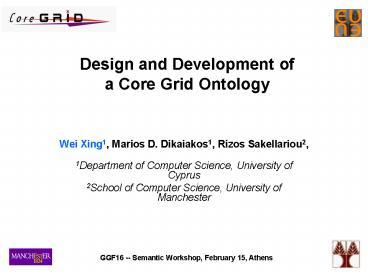Design and Development of a Core Grid Ontology - PowerPoint PPT Presentation
1 / 15
Title:
Design and Development of a Core Grid Ontology
Description:
1Department of Computer Science, University of Cyprus ... The concepts/terms of Grid entities, resources, capabilities and the relationships between them. ... – PowerPoint PPT presentation
Number of Views:42
Avg rating:3.0/5.0
Title: Design and Development of a Core Grid Ontology
1
Design and Development of a Core Grid Ontology
- Wei Xing1, Marios D. Dikaiakos1, Rizos
Sakellariou2, - 1Department of Computer Science, University of
Cyprus - 2School of Computer Science, University of
Manchester
2
Outline
- Introduction
- Problem Statement
- Building a Grid Model
- The Design of a Core Grid Ontology
- Implementation
- Conclusions and Future work.
3
Introduction
- Ontologies are among the key building blocks of
the Semantic Grid. - The concepts/terms of Grid entities, resources,
capabilities and the relationships between them. - Use Grid ontologies to
- Merge the information from different sources
- Build a knowledge base for Grids
- Deploy user-space information system
- Co-operate with semantic-able Grid services, such
as Resource Broker, Information Service, etc.
4
Problem Statement
- There is currently a multitude of proposed Grid
architectures and Grid implementations. - Different views or interests of a Grid entity and
its properties. - It is practically impossible that one ontology
can include all aspects of Grids, or thousands
of Grid entities.
5
Proposed Solution
- A Core Grid Ontology (CGO)
- A core framework for representing a Grid.
- Open and extensible for all kinds of Grid
architectures and Grid implementations.
6
Building a Grid Model
- The most difficult task for developing an
ontology - Capture a right model for the Grid
- Our view of a Grid.
- Grid UsersApplicationsMiddleware/ServicesRe
sources within VOs - The proposed layer-structured model.
- Three layers Users/Applications,
Middleware/services, and Resources.
7
A Grid Model
8
CGO Classes Overview
9
Defining properties
Based on the Constraints of the CGO Classes.
10
Representing Grid Entity
11
Representing Grid Entity using OWL
ltowlClass rdfID"ComputingElement"gt
ltrdfssubClassOfgt ltowlRestrictiongt
ltowlsomeValuesFromgt
ltowlClassgt
ltowlunionOf rdfparseType"Collection"gt
ltowlClass rdfabout"Jobmanager"/
gt ltowlClass
rdfabout"JobScheduler"/gt
lt/owlunionOfgt lt/owlClassgt
lt/owlsomeValuesFromgt
ltowlonProperty rdfresource"runningSevice"/gt
lt/owlRestrictiongt
lt/rdfssubClassOfgt
12
Generating Instances
13
Implementation
14
Conclusions and Future Work
- The CGO can be a key representation tool for the
Semantic Grid. - The CGO is able to express the basic concepts and
relationships of Grid entities and Grid
resources. - The flexibility and extensibility of the ontology
allows it to be used for Grid information
integration, information searching. - Next step
- Building a Grid knowledge base.
15
- Thank you for your attention!
- Questions?
- Comments ?































